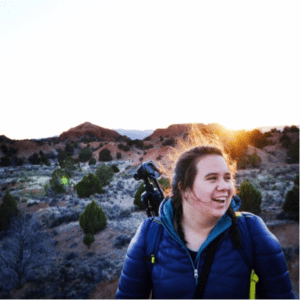By Janey Heyman
Moving from a small California beach town to Salt Lake City, I realized the night sky was a severely under-utilized resource in my childhood. I can only identify four constellations: the three-starred belt of Orion, the ladle-shaped Big Dipper and its younger sister the Little Dipper, and the cluster of the Pleiades. Now looking up at Salt Lake City’s sky, I can barely make out Orion amongst the shroud of sky glow produced by the city. A large urban center, Salt Lake City’s sky glow is dominating and can only be partially escaped by traveling up one of the many Wasatch front canyons. Even tucked away in the canyons, the large halo of light pollution coming from Salt Lake is still visible, and many of the fainter stars vanish. Finding pathways for solutions to our light pollution issues might just be as important as the solutions themselves. Communicating problems and respectfully listening to stakeholders makes resolutions more efficient and painless – especially when change can be so difficult to come by.
While light pollution is not as prominent or as hotly discussed as air quality, it still holds an important place at the table of environmental issues. In fact, light pollution actually worsens the smog that us city dwellers know all too well. According to Kelly Beatty* in the magazine Sky and Telescope, “Each night nitrate radicals (NO3), a compound destroyed by sunlight, build up in the darkened sky. As city dwellers sleep, it neutralizes some of the harmful nitrogen oxides (NOx) that foul the daytime air and lead to wheeze-inducing levels of ozone (O3). New research shows that this nightly cleansing action isn’t as effective as it could be — because nitrate radicals are being destroyed by light beamed into the sky by outdoor lighting on the ground.” This hidden issue could quickly become more main stream as scientists build the connection between air and light pollution.
Get notified when new articles are posted to the EDR blog – sign up for our email list »
The light pollution given off from the newly built North Campus Parking Garage on the University of Utah Campus had severe consequences for the nearby astronomical observatory, located directly south of the parking garage. The observatory is open to both students and the public for star parties on Wednesday nights. Although the nearby garage had dark-sky fixtures, the structure was designed with large openings. According to Bill Leach, Energy Manager for Facilities Management, it was indirect glare from the top of the parking garage that was causing the problem. Anil Seth, a professor in the physics and astronomy department, contacted Bill to discuss the difficulties that the new lights were causing on the observatory. Finding a solution that mitigates light pollution and promotes safety and security on campus is a work in progress, however they have been able to collaborate and substantially decrease glare for the observatory.
If you look around campus you will see large glowing orb lighting fixtures begin to disappear, slowly replaced by LED light fixtures angled down towards the pavement. Appropriate lighting cuts glare and directs light, which leads to safer spaces and a more effective use of energy. The fight against light pollution can seem never-ending, especially in a large urban area like Salt Lake. If the relationship between the Physics Observatory and Facilities Management teaches us anything, it is that open and cooperative communication will open the door to mutually beneficial solutions.
As the benefits of dark skies become more apparent and well-known, light pollution mitigation is going to be an important part of environmental dispute resolution dialogue. The University of Utah is already paving the way for changing the way we light our spaces by creating a new campus standard light, as well as starting the Consortium for Dark Sky Studies, the first ever academic center dedicated to discovering, developing, communicating and applying knowledge pertaining to the quality of the night skies.
In order to protect dark skies, we must utilize resources provided by organizations like the Colorado Plateau Dark Sky Cooperative and the International Dark Sky Association. It goes without saying that the greater problems of light pollution must be solved through collaboration not just on our campuses, but in our communities, cities, regions, states, and countries. Dark skies are integral to science, art, philosophy, and our shared human heritage. I am hopeful that in future years I will be able to look up toward the sky of Salt Lake City and teach others the many constellations I have learned – without having to leave the valley.
*Beatty, Kelly. “Night Lights Worsen Smog.” Sky and Telescope, 15 Dec. 2010, www.skyandtelescope.com/astronomy-news/night-lights-worsen-smog/
 Janey Heyman is an intern for the Colorado Plateau Dark Sky Cooperative and the Consortium for Dark Sky Studies. She is also an undergraduate student studying ecology, sustainability, and parks, recreation, and tourism. She loves to spend time under the stars, and is enjoying the process of adding constellations to her identification repertoire. Janey is also fond of the growing astro-tourism opportunities provided by outdoor recreation.
Janey Heyman is an intern for the Colorado Plateau Dark Sky Cooperative and the Consortium for Dark Sky Studies. She is also an undergraduate student studying ecology, sustainability, and parks, recreation, and tourism. She loves to spend time under the stars, and is enjoying the process of adding constellations to her identification repertoire. Janey is also fond of the growing astro-tourism opportunities provided by outdoor recreation.
